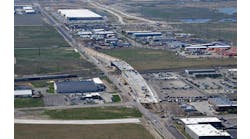By Brad Barth, Contributing Author
Severe storms have battered infrastructure supply chains across the U.S., exposing the fragility of a traditional construction model where risks are not equally shared among stakeholders.
Floods and wildfires have disrupted ports, railroads, highways, and raw materials such as lumber, demonstrating how weather can form a point of failure across infrastructure supply chains.
Vulnerabilities are interconnected and equally affect project schedules, scope, and cost. This requires coordinated risk management and mitigation among all project partners.
The traditional project management model of separate stakeholders focused on risks within their own silo leaves supply chains unable to adapt to sudden and systemic risks, such as unpredictable extreme weather events. These status quo methods often exclude key suppliers from risk planning and decisions, and data and risks are not equally shared across all stakeholders.
Rising investments in highway and bridge construction are increasing the strain on supply chains. Squeezed by inflation, infrastructure projects also tight margins. The frequency of extreme weather events exacerbates logistics challenges that can lead to infrastructure project delays.
Extreme weather can have a ripple effect across separate suppliers and logistics chains. In 2021, Hurricane Ida not only knocked out industrial plants in Louisiana that produce much of the plastics essential to PVC drainage pipes, but it also exacerbated logistical shortages by diverting trucks for relief aid.
The push for environmentally sensitive construction also means that contractors need to consider a broader range of procurement factors.
Extreme weather events can have an effect across new project constraints like carbon reduction targets. Storms disrupting transport routes can force suppliers to travel longer distances, resulting in higher emissions associated with the project.
Measuring construction projects against environmental impact scorecards across their lifecycle is a relatively new challenge in the U.S.
The complex web of interdependencies between supply chains and weather-related logistical challenges renders ineffective the traditional project planning model where risks were considered in isolation by separate partners. Instead, what is needed is a risk management approach capable of collectively managing the relationship between all risks and project constraints, across all stakeholders.
The construction industry should adopt shared-risk models. This incentivizes data integration and collaborative risk management. But the industry must embrace interoperable management systems that can connect project teams.
Connected data will help highlight common vulnerabilities across supply chains and inform collective mitigation measures. Historical data on how extreme weather events affected past projects can also be incorporated into new projects so that contractors can reduce reliance on vulnerable suppliers in storm-affected regions.
This way, painful lessons learned on one project can lead to better planning on the next. Integrating past and present data can facilitate a benchmark-based, risk-adjusted planning process that creates more realistic expectations.
Advancements in artificial intelligence and machine learning will soon fulfil the promise of real-time, continuous risk assessment as a project moves through its lifecycle. Such systems will run simulations, evaluate alternative scenarios, look for patterns and anomalies, and surface risks that would otherwise be missed.
That vision requires data for the system to “learn” from, further justifying investment in a modern project controls platform. The data captured from today’s projects will be fuel for the AI-based planning engines of the future.
Understanding the risks associated with critical materials is more important than ever. In today’s economy, an extreme weather event on one side of the globe can affect projects on the other side.
Contractors and suppliers must uncover those risks, assign probabilities, and quantify them so that appropriate cost and schedule contingencies can be baked into the plan. This will require the construction sector to move away from the old, siloed, sequential construction models built around competition toward collaborative models where all partners have the collective visibility and responsibility to address shared risks.
Integration will enable holistic, whole-system risk management capable of anticipating and adapting to a new landscape. R&B
Brad Barth is the chief product officer at InEight



